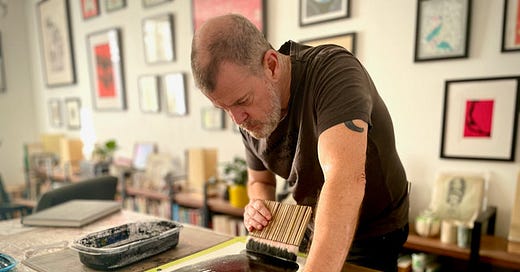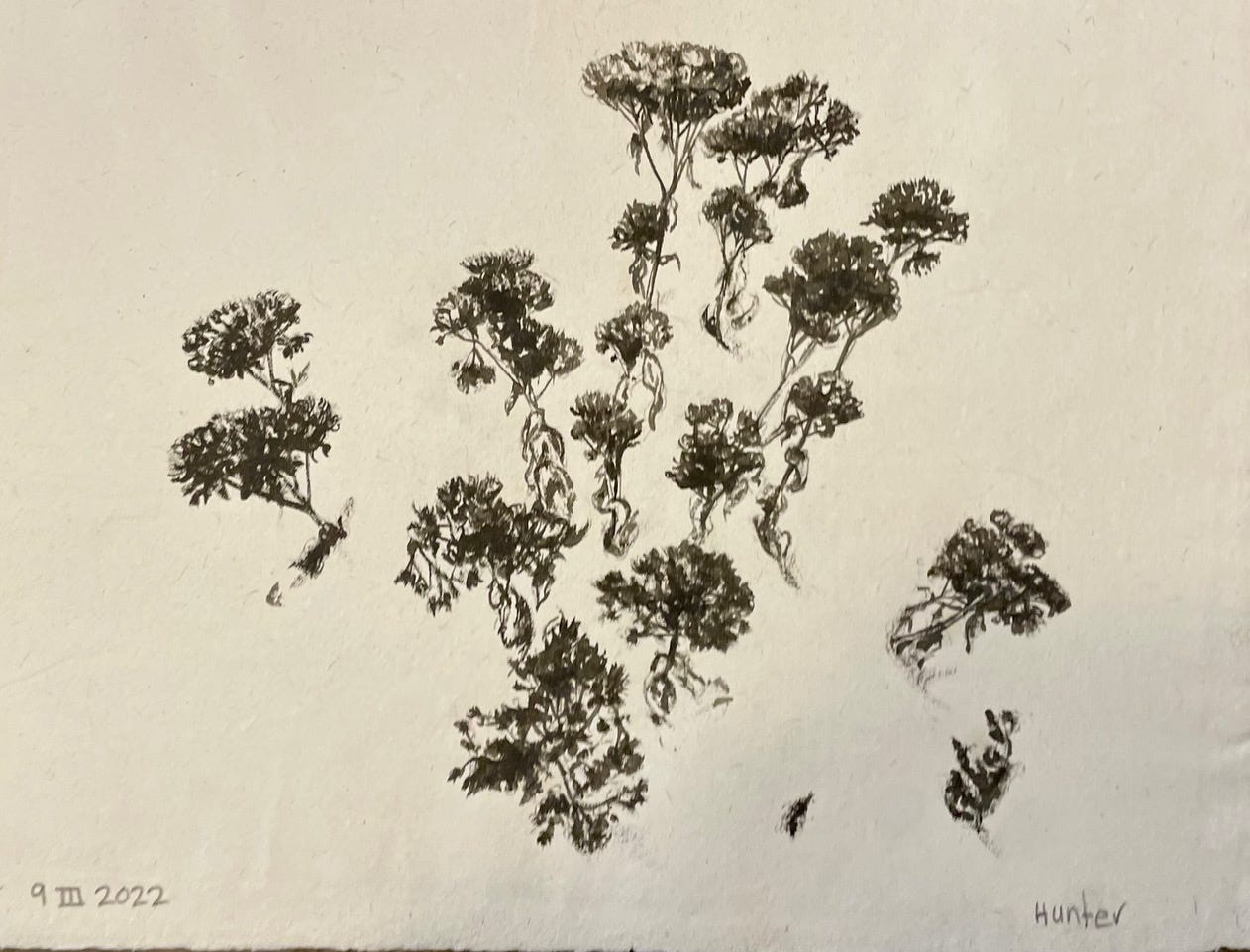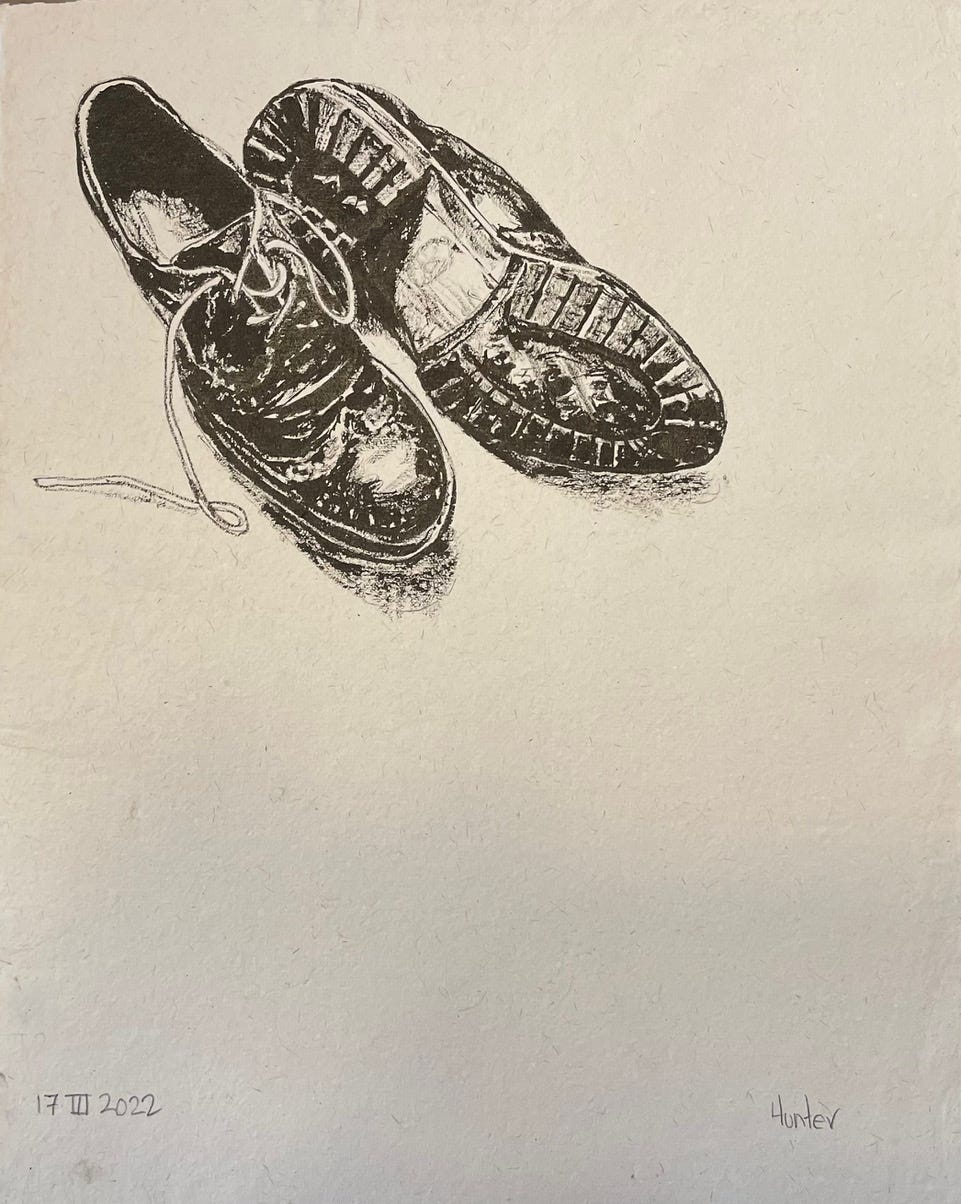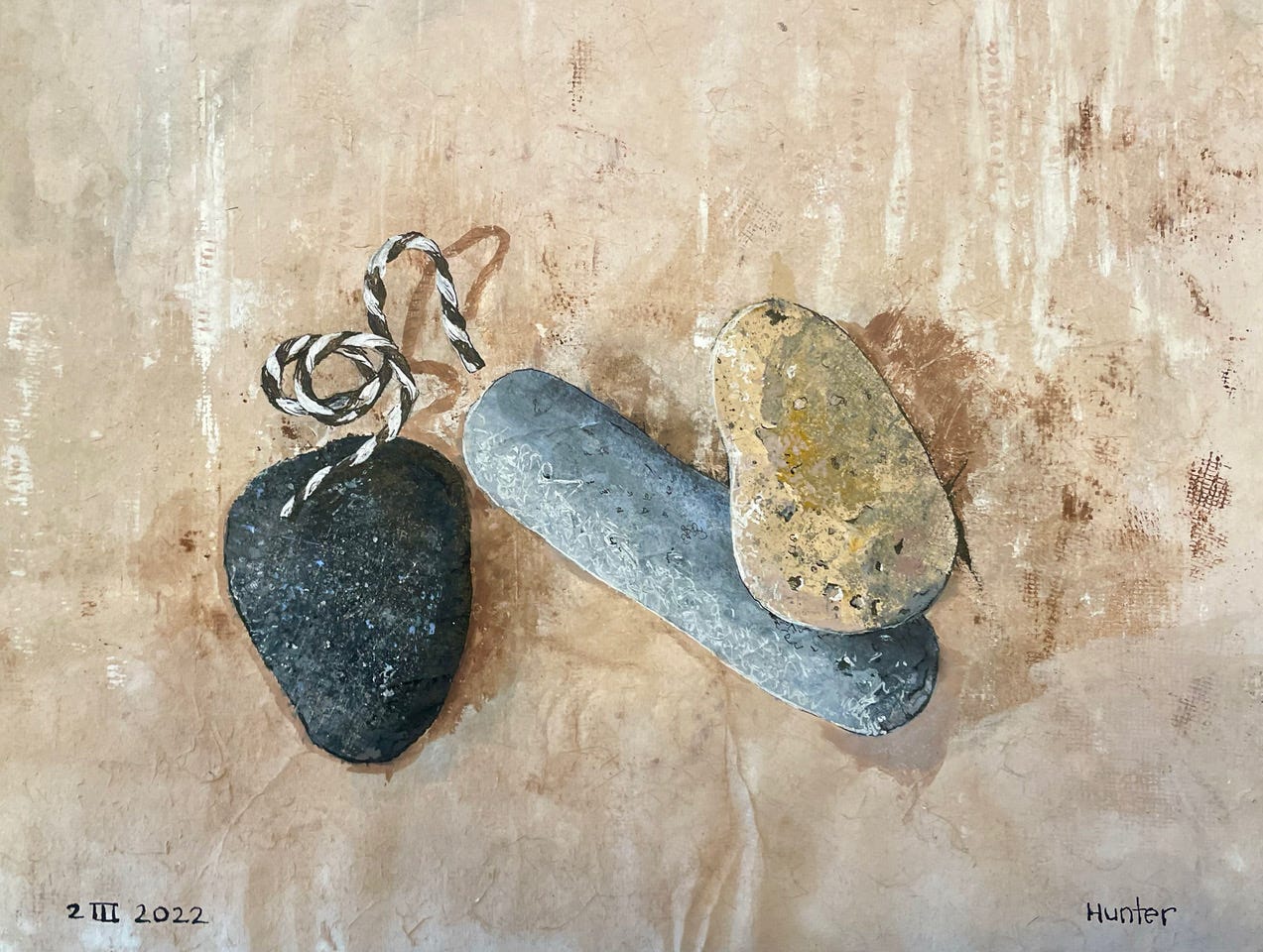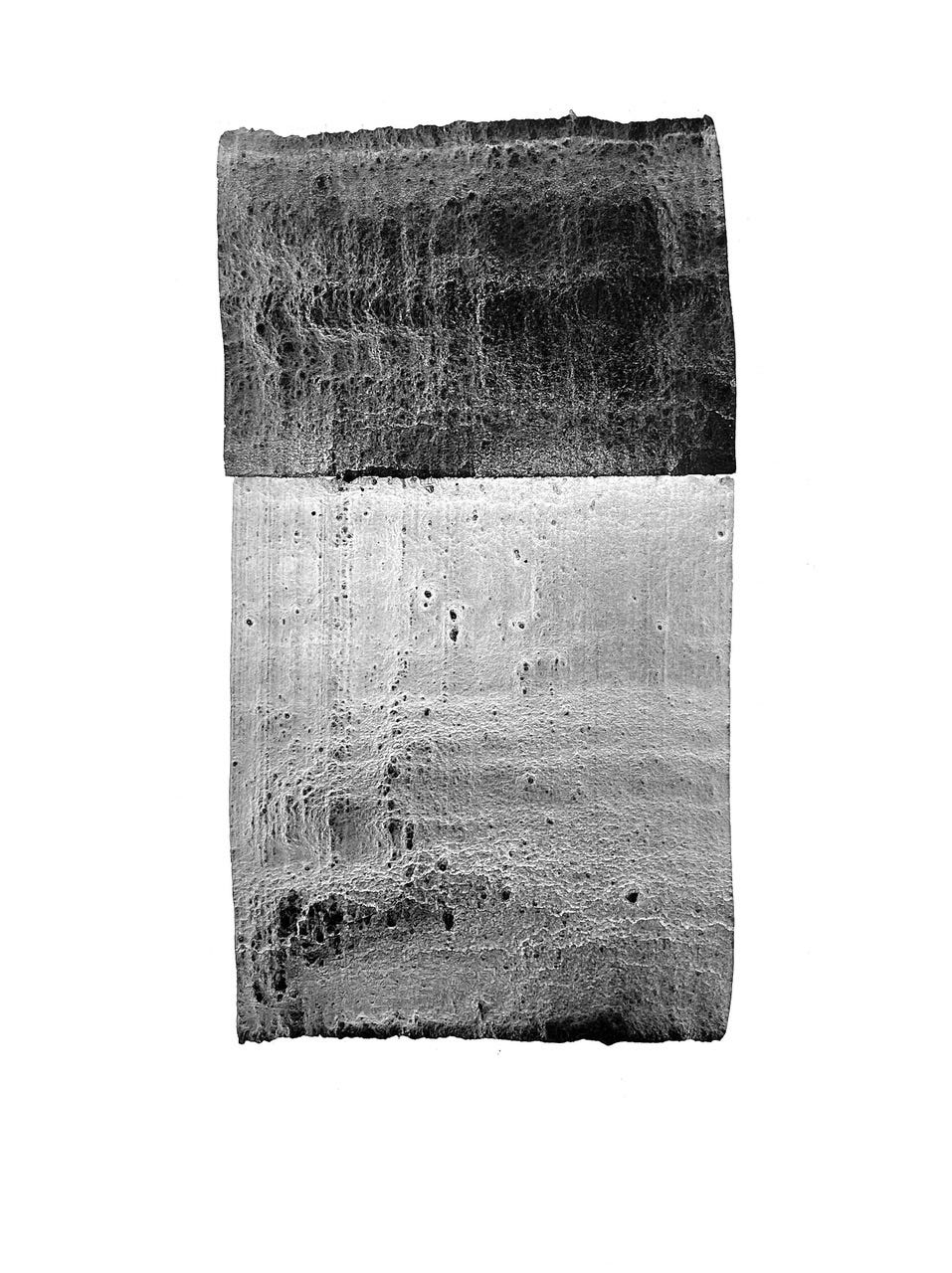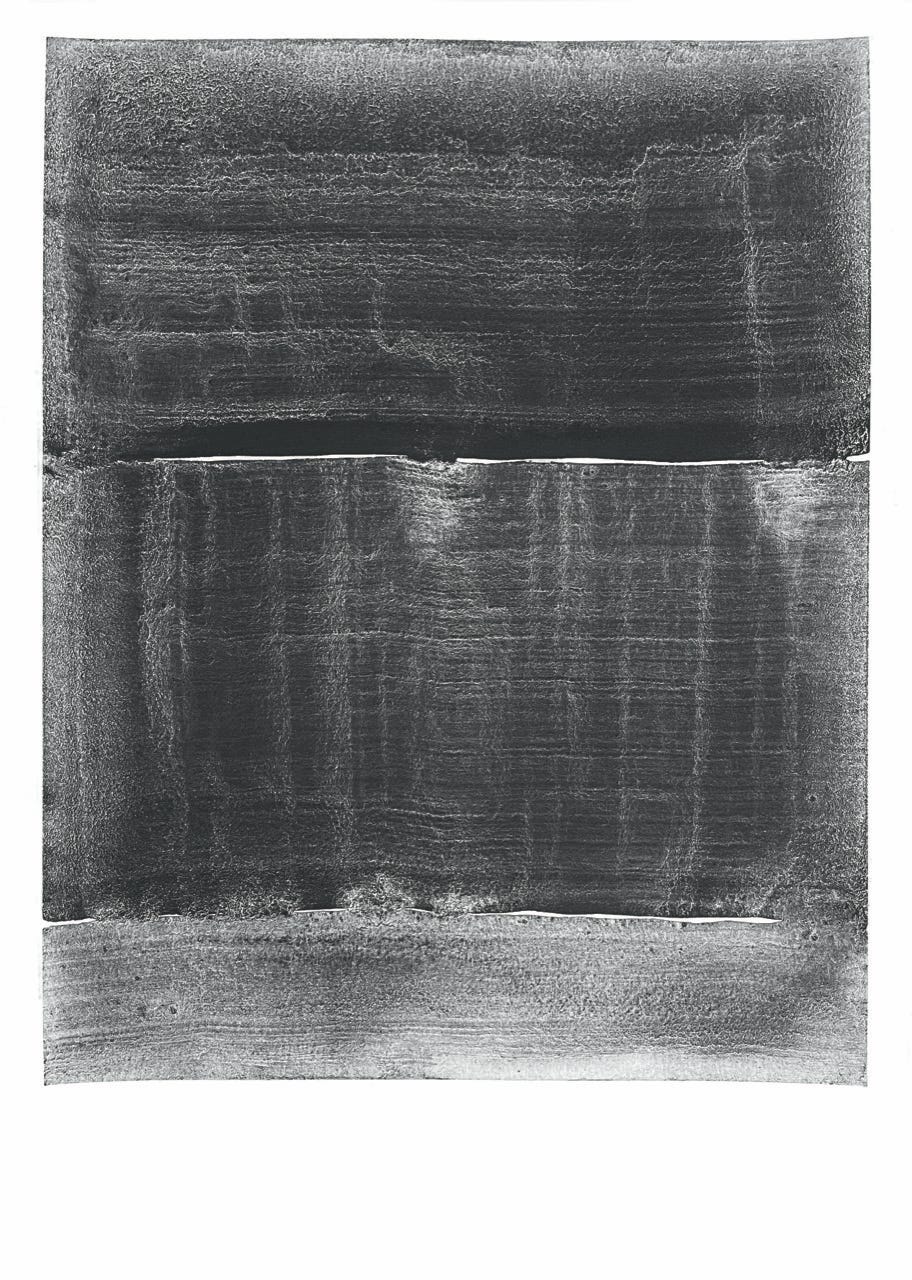Happy New Year dear readers ! I have been thinking about ways we can create community and solidarity online for the Ageless Artist who is working continuously to grow and make art to sell or because its their lifeblood. We are situated worldwide and our commonality is our love and creation of art. My intention always has been to encourage the artist of my vintage-a little younger or older perhaps - to share their stories and challenges as an artist in this place in time. We understand the world has shifted and changed since our early artist days and how could it not? How we navigate these times as an artist is personal -but often requires a shift and perhaps new opportunities to try out new skills and approaches to our profession . Growth is possible and imminent. Here at “Get your Artist Jetpack On” we will be learning from artists who continue to forge new paths in their art practise!
In this post we learn about Artist and writer Paul Hunter currently making his art in owen Sound , Ontario ,Canada!
Paul Hunter is an artist, writer, and printmaker. He graduated with honours from the Ontario College of Art and is a member of the Arts and Letters Club of Toronto. His art is driven by an interest in mark-making, process, and nature and is held internationally in public and private collections. His writing has been published in Canadian Zen Haiku magazine, Spezzatino, The Literary Review of Canada, and the internet journal Contemporary Haibun Online. Most recently, his work was published in Conversations with William T. Vollmann (University Press of Mississippi, 2020) and Essais: works on paper 2022–2023 (Mammoth Hall Press, 2023). He is also co-proprietor of Mammoth Hall Press which he started in 1990 with his wife, the artist and designer, Leah Springate. Their private presses’ prints and handmade books have been exhibited across Canada and Japan. In 2021 they moved from Toronto and now make their home in Owen Sound, Ontario.
Winter blossoms, sumi ink drawing on handmade paper.
Were you always creative?
Definitely. I’ve always made art, my earliest memories are of drawing on anything I could get a hold of. The telephone table in our front hall had envelopes that I would cover in sketches. Our neighbour would sneak a couple into his pocket whenever he visited. He told me they may be worth something someday. Similarly, I wrote stories on scraps of paper and in old school books. My mother worked at a publisher and would take them to the office and type them up for me. I guess the interest that people took in what I was doing reinforced the drive to continue. Sometimes a simple pat on the back is all you need to keep the fire burning.
Do you sometimes create just for yourself?
My personal work is always driven by my current interests. My writing is the same, I find it very satisfying. It answers something different than the visual arts for me, though. In the work I do for Mammoth Hall Press with my wife Leah, it is a mix of perspectives. They are print and design projects that are enjoyable for us but need to be marketable. The collaborative work is exciting as you arrive at destinations you may not have set off for.
Who were your early influences and have they changed over time?
In the early eighties there used to be a Canadian television show. I don’t remember the name. The Creative Eye, The Critical Eye, something like that. The show spotlighted Canadian artists in 15–30 minute segments. What I do remember is that the co-host was the art historian Alan Gowans. The show was my first introduction to K. M. Graham, John Scott, Toni Only, Ivan Eyre, among many others. Before the internet this was what you relied on as a young artist. Two episodes struck me and the artists became lifelong favourites. Saskatchewan’s Otto Rogers and Jack Shadbolt from British Columbia. When I studied printmaking in college I was completely taken by Helen Frankenthaler. I studied her woodblock prints from the 1970s. These artists were my three pillars.
The older I get the more my approach is set. I don’t magpie the tinsel of other artists like I did when young and still searching for my voice. Now I’m more interested in process, how the artist approaches their practice. There are more ways to tackle a work of art than there are artists. I love discovering some perspective or technique I’ve never seen before. My new list would include John Virtue, Ilse d’Hollander, Suzan Frecon. Oh, this could take a while…uh, Raoul De Keyser, Ian McKeever, Yun Hyongkeun, Mamma Andersson. James Bishop, Beatrice Caracciolo, and Margaux Williamson, I’ll stop there.
Of the writers that most inspire me I couldn’t list, we’d be here too long. The ones that, without their existence, the world would be a sadder place are easy. They are poets Ted Kooser, Anne Carson, Annie Dillard, T’ao Ch’ien, and Mary Oliver. The writers would be Diane Ackerman, John Berger, May Sarton, and David Markson.
What is your current passion? What energizes you as an artist?
I would go back to what I said earlier, discovering artists I’ve never heard of. Reading on any subject, to always be learning. The late, great designer, Massimo Vignelli, believed we should work toward intellectual elegance. The idea stuck with me. He described it as “elegance of the mind.” That we should cultivate a mind continually refining itself with education and knowledge. With that I would also add walking in nature, it wakes up the senses.
My shoes, sumi ink drawing on handmade paper.
You recently moved to Owen Sound from Toronto,Ontario Canada . Did the change of environment, moving from a large city centre, impact or influence your art practice?
Very much so. Part of the incentive to move up here was to be near trees and water. Proximity to nature was very important in our plans. Before we left Toronto my drypoint prints were of brutalist highway structures. They were always dominating the view where we walked. Kokoschka pointed out the impossibility of doing a portrait of a city. Once you finish it, the city’s already changed. Toronto was changing quicker and quicker. Constant construction. The pace up here is more suited to our personalities. I do a lot of tree studies now, I think that’s a better use of my attention.
Three stones and string, mixed media drawing on handmade paper
How long has it taken for you to develop your individual style?
In 1970, in kindergarten, I was painting a head on construction paper. Remember those times? The joy of art back then. I had an absolute flush of realization that the head had ears! I looked around and nobody else had noticed. So, I really looked at my classmates and scribbled in eyebrows, nose, cheek bones, necks. OK, so what’s the tally from then? 53 years? No, I’m joking, it more describes how attention has played a part in my development from the start. There’s that focus on attention, again. My style is still changing, always moving. We talked about this before, didn’t we? Or I commented on one of your posts. I said, no one wants to be chewing on that same old bone forever. As long as you’re always learning you work should always be evolving.
Tell me how attention impacts your creative process.
That depends on what I’m working on. With drawing, which is an important part of my practice, it is the question of likeness. Paying honest attention. With the work Leah and I do together as Mammoth Hall Press, it is all planned and measured. With printmaking you need to pay attention to the parameters of the work. Method, material, and media. Now, with my own, personal work, anything goes. The attention is looking at what I’ve done and try to imagine it as a stepping stone. What could be the next step? I have an idea of a combination of things I’d like to try and I don’t know where I’m going until brush hits paper, so to speak. So, I keep eyes and mind open.
Evening breeze, this moment, silent as blue, charcoal ink painting
Do you begin with a plan or finished piece in mind?
No, not in my personal work. I sometimes have an idea, a direction, or shape. It all begins with reading. Artist monographs, essays, nonfiction, poetry. Always looking at a variety of artists’ works at the same time for inspiration. There are always exhibition catalogues coming in from small galleries around the world. I like to cast a big net. It’s difficult to explain the moment an idea ‘clicks’. My last show at the Easel Gallery (Essais: works on paper) came about through my interest in techniques. Those of Scottish artist Callum Innes and Korean artist Lee Bae. I had recently finished a series of watercolours inspired by randomness. I had seen a video of John Cage’s experiments with ‘chance operations’ at Crown Point Press. I had an app that randomly chose two colours in watercolour and gouache. All I did was paint a single, wide swath of the colours. They were successful, beautiful. It’s like the flush of realization I had in kindergarten. The monograph, Essais: works on paper 2022–2023, contained two pages of references. It included all the books and videos that I was reading or watching at the time.
How do you name your pictures?
So many ways. In my last show say, I had sixty paintings that needed titles. Needed titles? Well, people like to have them to distinguish one work from another. The question is how to name sixty paintings after the fact? I decided on using a variation of chance operations. I selected fragments of my poetry, put them on little scraps of paper and put them in a bowl. I then laid all the paintings out on the floor and my wife dropped each scrap on a painting. That was how it went.
Unfurnished rooms, ghosted towns, charcoal ink painting
With that interest in the overlap between poetry and art, do you still read poetry?
I read one or two poetry books a week, maybe three. This week was Elizabeth Bishop’s Geography III and Gabi Abrão’s Notes on Shapeshifting.
When do you enjoy creating?
I like to read and write early then make art in the afternoon.
How do you deal with distractions? Do you go with the flow or push yourself a little?
I want to say I handle distractions quite well but it depends on the situation. We once had a friend staying with us and I began painting early in the morning before they got up. But, I am not always that flexible. It depends on the distraction though.
What lessons have you learned as an Ageless Artist?
Scheduling my day helps me focus and keeps my attention on what’s important–creating. If I wait for inspiration to strike I’d never get work done. Inspiration is all around but it needs to find you working, as the saying goes. My wife and I actually schedule our year, month, weeks, and days. It’s very organized but also rather flexible. We shuffle new interests forward and pipe dreams back as opportunities change. It keeps us from idleness and procrastination. Annie Dillard called a schedule a “net for catching days” and I find that to be true. And they can be very productive days.
Do you find it easier or more challenging to navigate the various types of social media and has it impacted your art practice over the last few years?
Now, I only use Instagram and it has opened up connections with the art world at large. I see the working methods of other artists, new works, new styles. It’s amazing because it’s at your fingertips. Remember when we had to track down and buy art magazines? Canadian Art, Artspace, artscanada, Art News, I still have boxes of old issues. You would have to dedicate serious time to reading them. My problem with “social” media is that the social connection is questionable. In two hours you’ve flipped through 300 artists and advertisements. How much have you actually learned about the art? Not much. Your feed is catered to you. It’s business that drives it, not community. There are a lot of artists that have 25K followers and follow 240. You look around and see people thumb their way from post to post, blindly dishing out hearts. I find to make the app more social, if I heart something, I comment explaining what I like. We need to slow down our interactions with social media. Otherwise the “heart” either means nothing or it’s a business decision.
Do you feel motivated to keep learning more about strategies to enhance your art business?
I wouldn’t say ’motivated’ but we do dedicate time each week to explore ideas. It’s usually in relation to Mammoth Hall Press but it affects both of our personal output. It’s a necessary evil, isn’t it? In an ideal world you would make art and wealthy patrons would just be banging at your door. Unfortunately, that’s not how it is.
Are you finding a balance between creating and promoting your work?
That’s a hard one. I’m getting better but it’s far from balanced. The problem is I find it more enjoyable to produce than promote. If it didn’t take so long to write copy, make videos, take product shots, you know? There’s so much palaver and all you want to do is get back to making art. It is something that Leah and I have planned for 2024. Shoehorn it into our week.
What would constitute a perfect day for you?
Few interruptions and a good pot of tea.
What words of personal wisdom would you like to offer to other artists?
Always remember why you make art. Your art practice is precious, its the way you measure the depth and breadth of your one amazing life. Pay attention to it, take care of it, and stay true to it. Old Matisse, bed-ridden, never stopped creating. Neither should you, keep at it. Work hard and be nice to new artists. Be an inspiration. As I said before, a simple pat on the back is all you need to keep someone’s fire burning.
Light bulb, mixed media drawing on handmade paper
As you are also a writer is there a sample of your writing you would wish to end on?
Sure, this haibun I wrote many years ago and recently came across again. I was quite moved rereading it, so, I believe I got it right. A haibun is a Japanese form that includes prose and haiku. It is my favourite method of writing requires a balance between the two parts. The haiku needs to mirror the sentiment of the prose but not repeat anything. This particular piece reminds us of the power of a photograph as time capsule.
Here is a Polaroid taken over fourteen years ago. It is of a small kitchen at the back of an old schoolhouse during the reception at our wedding. In the picture, taken by my dad, my wife’s father is doing dishes while my mother dries. My father-in-law, Burt, has his sleeves partly rolled up and looks over his shoulder at us, smiling his sweet smile. My mother is dressed in a pink blouse and looks at the plate she holds wrapped in a dishtowel while laughing at something my father has just said. This is my parents’ first wedding for one of their children and my in-laws first wedding for a daughter, it is a special day. It was a very small service and we had very few people attend, our parents seemed to spend most of the time joking and doing dishes in this kitchen. I don’t know what they talked about all that time but if this picture is any indication, they were happy. They have all since passed away and this is the only picture I have that contains the presence of all three of them. In it they are still healthy and laughing, enjoying that day with us—our wedding day. I sometimes imagine stepping through the fragile white border of this picture into that room with them again. I wouldn’t tell them that fourteen years from that moment they would all be a memory, how sickness would take them all, how heartbroken we would be and how they would be missed long, long after they were gone. I wouldn’t speak at all; I’d stand against that green fridge and listen to their small talk and laughter, enjoying these small moments I foolishly overlooked when they were alive. I would then remember that Aunt Flo, grandma Stagg, Vera, Aunt Eleanor are all still alive out in the main room of this fantasy and I would go visit them one last time as well.
at the end of the day
the tree will be bare
See Paul’s monograph: Essais: works on paper 2022–2023
https://www.amazon.ca/Paul-Hunter-Essais-works-2022-2023/dp/B0C9SFNRT7/
Visit Mammoth Hall Press: mhpress.ca
See Paul on Instagram: https://www.instagram.com/dogdaycurator/
Ah thank you for sharing Paul!! I am cheered you put so much effort and thought into this !

